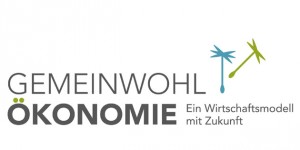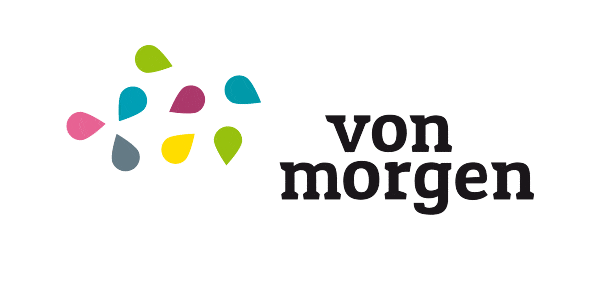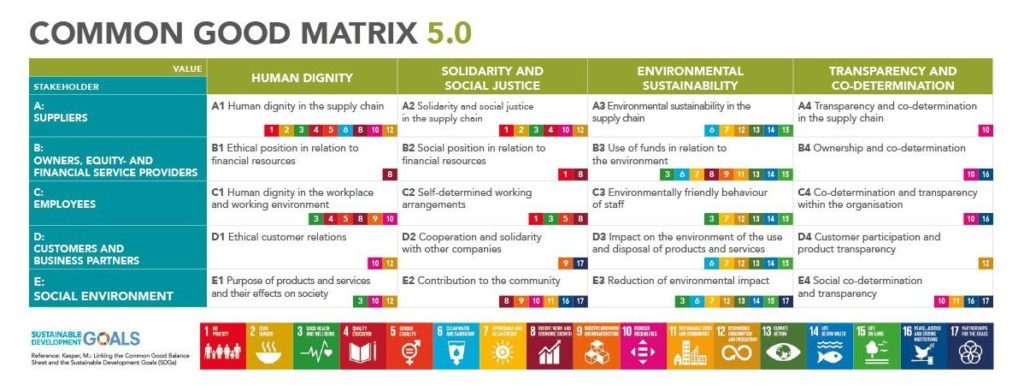From tomorrow creates transparency: Companies can be evaluated by all users and employees on the basis of positive factors for their public welfare orientation. The more comprehensive the public welfare orientation, the larger the pin is displayed on the map, which is intended to allow users to already live in a world of tomorrow today.
[Toc]
Inhalt
The system of positive factors
About the positive factors, the users and regional pilots, as well as the initiatives and companies themselves, have the opportunity to present and describe their efforts for humanity and sustainability in an objective and systematic way.
You can add as many positive aspects as you want. (Negative aspects you can add too and rate “from yesterday”). Every positive factor needs to be categorized in on of the 6 dimensions of the positive impact leaf. You can only add on aspect per rating. The six aspects are sorted by the three pillars of sustainability:
- Planet:
- Diversity: Ecological diversity, organic certifications, few chemical additives etc.
- Renewability: Environmental protection, short transport routes, efficient/ low use of resources and energy, circular economy etc.
- People:
- Fairness: Safe, inclusive, fair and appropriate working conditions throughout the entire value chain.
- CoCreation/ Humanity: Do all participants have room for their own ideas, personal development and cultural diversity? Are there rights to participate and democratic processes?
- Economy
- Solidarity: Cooperative working, sustainable and ethical financing and investments, in consideration of all consumer budgets, etc.
- Transparency: Are production, financing and retail-chains publicly comprehensible?

The Future Assessment


Procedures for evaluation
The positive factors are entered in a special comment box. The user must provide the following information:
- Choose a positive factor: Select one of the 6 positive factor categories to which the aspect should be assigned.
- Describing aspect succinctly: In 140 characters create a kind of “headline,” which makes clear what is so good here.
- Enter comment: Write comments (unlimited) and provide you with source. (At best, with a link that will then be shown directly as a preview.) This comment can then be replied to by other users.
- Assess future viability: Click on a button between “the day before yesterday” and “from the day after tomorrow,” which stores the positive factor directly.
Examples as rating orientation
The following table shows a few key aspects of future viability and how they can be evaluated.
Open bigger table: goo.gl/VLuwWJ
Commongood economy

The positive factors were developed in close cooperation with activists of the common good economic movement and yet have the claim to make sense immediately for the layman. The comprehensive matrix of the public welfare, on the basis of which all aspects of the company would be illuminated and punctured according to a fixed grid, requires professional auditors and consultants.
Nevertheless, on the map of tomorrow, we want to give an opportunity to specify all the necessary aspects (anonymously). Our claim remains that GWÖ autidors will one day be able to use the map of tomorrow as a crowdsourcing tool, where all stakeholders in an organisation (suppliers, donor association owners, employees, witnesses and the social environment) will be able to use their aspects Be transparent.
Doughnut Economy
The rating system in the Map of Tomorrow is very similar to the Doughnut of Kate Raworth:
- The first two rating questions refer to the ecological boundaries, which is outsied of the Doughnut
- The third and fourth questions refers to the social foundation inside the Doughnut
- And the last two questions refer to the kind of solidarian economy we create to stay inside the dogunut.

Kate Raworth explained even better our rating-Schema in her Presentation at the Pioneers of Change-Summit 2019, when she explained, how a sustainable economie lies within the limitation of the Earth and the needs of the Society. And with Household and Commons (apart form Market and State) she includes nicely what we question with “Solidarity” in our fith question of the ratingsystem.



No Comments Yet